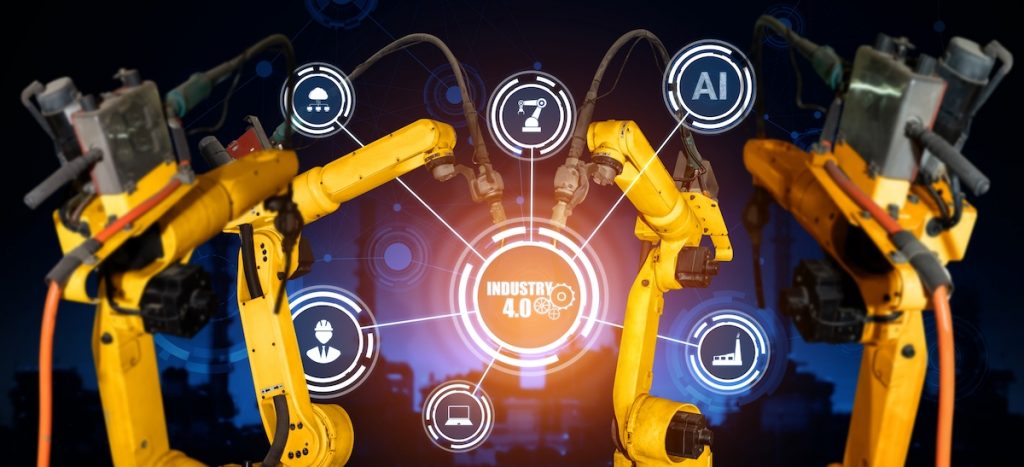Industry 4.0 and Open Innovation
One buzzwords nowadays is “4th Industrial Revolution”. Let’s ask ourselves: What are we talking about when we say “4th Industrial Revolution”? For sure, we are talking about a huge potential of innovation in Industry 4.0. Numerous studies have attempted to quantify the opportunities, and all talk about BIG numbers, in terms of number of connected devices, global connections and economic impact. For instance:
- Gartner forecasts by 2029 more than 15 billion IoT devices will attach to the enterprise infrastructure
- Ericsson’s Mobility Report forecasts 26,9 billion IoT connection by 2026 (it was 12,6 in 2020)
- McKinsey assessed a potential global economic impact up to USD 3,7 trillion by 2025 for Manufacturing, out of a total 11,1.
But again:
What is “4th Industrial revolution” about: is it a technology game?
Surely, we have in front of us a long list of disrupting technologies, as never before in the history of human being. To quote some of them: IoT, Cloud, Big Data, Artificial Intelligence, Machine Learning, Augmented Reality and Virtual Reality, 3D printing, 5G and many others. But: no, it isn’t (only) a technology game!
There are multiple factors driving industry transformation (Industry 4.0). Among them, two drivers are of paramount importance: making money and saving money. These 2 major factors are driving business to adopt Digital Innovation. Vertical industries and enterprises are undertaking Industry 4.0 initiatives primarily to save money and to be more competitive by making things better, faster & cheaper. Other important factors beside the need for new revenues and cost savings, are: regulatory compliance and environmental concerns, improved customer intimacy, need to manage multiple relationships, and many others.
All industries ranked ‘becoming a digital business’ as one of their top 10 objectives (ref. Gartner’s CEO survey), while IDG found that 9 out of 10 companies plan to adopt a digital strategy.
Still many companies feel they are not ready for this transformation. Only 29% feel they are prepared, according to a recent survey made by The Economist.
1 out of 2 Companies spent 1-2 years in piloting, 20% even longer according to World Economic Forum. What is preventing the needed transformation?
Major challenges to be successful in the Digital Transformation:
- Limitations in resources and skills
- Limited transformation experience
- Huge upfront investments (with difficulties in ROI calculation)
- Cultural limitations
- Complex relationships with many partners
More about Industry 4.0 challenges
Open Innovation can contribute to find potential solutions for (some of) the challenges.
“Open Innovation”: this expression was coined by Henry Chesbrough in 2003, as opposite to traditional “closed” R&D-driven innovation. The term was originally referred to as “a paradigm that assumes that firms can and should use external ideas as well as internal ideas, and internal and external paths to market, as the firms look to advance their technology”. More recently, it is defined as “a distributed innovation process based on purposively managed knowledge flows across organizational boundaries, using pecuniary and non-pecuniary mechanisms in line with the organization’s business model”. The latter definition acknowledges that open innovation is not solely firm-centric: it also includes creative consumers and communities of user innovators, and innovations can easily transfer inward and outward between firms and other firms and between firms and creative consumers.
You may say: “2003…it’s 2021!”
Yes, the concept is quite old, but not so far widely adopted. As an example: ONLY 1 out of 3 Italian Enterprises adopted an Open Innovation approach, only 1 out of 10 since +3years (Source PoliMi, 2019).
Futire of Industry 4.0 and Open Innovation
Since Innovation is crucial for future success, it is important to start open collaborations with an extended network of EXTERNAL Partners. To do so, it is needed to create and manage a wide set of RELATIONSHIPS, also beyond own traditional value chain. You may find not only Suppliers and Partners, but also Universities, Incubators, etc. Here comes another “buzzword”: ECOSYSTEM
It is not only dealing with Start-ups, but also other players. Anyway, scouting for start-ups is crucial: 54% of Fortune 500 Companies have collaborations with StartUps.
Actions that can be done with Industry 4.0 and Open Innovation
There are more than a dozen of actions that can be done with such potential Partners:
- Corporate Contests
- Start-up M&As
- Partnerships with Incubators and Accelerators
- Corporate Spin-off / Spin-out
- Corporate VC
- Call for ideas
- Research Projects with Universities
- Corporate accelerator
- Hackathons
- Crowdsourcing
- Start-up scouting
- Joint labs
- IP acquisition
- Partnerships with start-ups
Stages and Risks of Industry 4.0 and Open Innovation partnership
We may identify 3 stages, with an incremental need for Level of Investments and Digital Skills. There are 2 risks that MUST be avoided:
- The “INNOVATION THEATRE”, i.e. just to communicate that “we are going digital” a company define a Digital organizational structure without providing enough budget; and
- The “LEAP IN THE DARK”, i.e. the opposite, allocating budget without having the right skills/process/…
In the FIRST STAGE (“INBOUND OPEN INNOVATION”) the main objectives are:
- to find innovative ideas and potential partners (e.g. Start-ups for new technologies/solutions and Universities for new inventions, patents, etc), and
- to disseminate inside the Company a Digital Innovation culture, an attitude to act as innovators/intrapreneurs. Very useful to get ideas are Hackathons (but also Datathons and AppThons), Call for Ideas, Corporate Contests and
In the SECOND STAGE (“OUTBOUND OPEN INNOVATION”) the Company really starts to innovate, establishing the proper processes to manage the ecosystem. More internal skills are required and more partners jump in (e.g. Incubators, Accelerators). Here the Company may decide to co-invest with Venture Capital so that it can acquire from outside, IP, know-how and assets. It is also possible to establish Joint Labs or sign Partnerships with Start-ups or other Companies (industrial or commercial agreements, where 2 parties agree to develop a common project).
In the THIRD STAGE (“CORPORATE ENTREPRENEURSHIP”) a Company is fully able to manage and enlarge the Open Innovation ecosystem, and may decide to start M&As, to launch Corporate VC initiatives as well as Corporate Accelerator.
There isn’t a single recipe for a successful Open Innovation strategy, but for sure there is a list of ingredients that must be mixed.
FAQs about Industry 4.0 and Open Innovation
What are the trends in Industry 4.0 technology?
The trends in Industry 4.0 technology include the widespread adoption of IoT and smart sensors, increased use of artificial intelligence and machine learning, advanced robotics and automation, decentralized and edge computing, and the integration of digital twins for real-time simulation and analysis.
What are the lead innovations in the fourth industrial revolution?
The lead innovations in the fourth industrial revolution include cyber-physical systems that connect the physical and digital worlds, IoT for extensive data gathering, advanced analytics and AI for insights and decision-making, and smart automation and robotics for efficient processes.
How can Industry 4.0 help your company achieve value innovation?
Industry 4.0 enables value innovation by optimizing operations, reducing costs through automation, improving product quality with real-time monitoring, and fostering agile responses to changing market demands. It also facilitates the creation of new revenue streams through data-driven services and products.
What is the innovation of the fourth industrial revolution?
The innovation of the fourth industrial revolution lies in the convergence of digital, physical, and biological technologies. It involves the seamless integration of IoT, AI, advanced robotics, and other cutting-edge technologies to transform industries, enhance productivity, and drive economic growth.
About the Author
 This article was written by Antonio Mosca. Innovation manager certified by the Italian Ministry of Economic Development and the National Body for Digital Transformation. For over 20 years at the helm of digital innovation and business transformation initiatives, both in multinationals (Korber, Ericsson, Microsoft, EIT Digital) and consulting firm (Accenture, Ernst & Young). He recently founded New Digital Solutions, which offers consulting and solutions for Innovation and Digital Transformation.
This article was written by Antonio Mosca. Innovation manager certified by the Italian Ministry of Economic Development and the National Body for Digital Transformation. For over 20 years at the helm of digital innovation and business transformation initiatives, both in multinationals (Korber, Ericsson, Microsoft, EIT Digital) and consulting firm (Accenture, Ernst & Young). He recently founded New Digital Solutions, which offers consulting and solutions for Innovation and Digital Transformation.



